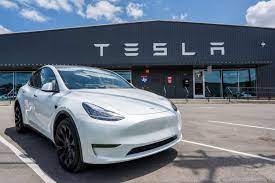 In the early part 2024, CalMatters reported on a series of bumps in the road for EVs, even though consumers continued to buying them in record numbers. The setbacks included Hertz selling about a third of its global electric vehicle fleet, replacing them with gas-powered vehicles. Ford in January announced that it was reducing production of its F-150 Lightning electric pickup truck after scaling it up last year. Tesla sales in California dropped 10% in the last three months of 2023, when compared to the same quarter a year earlier, according to data from the California New Car Dealers Association. And some automakers last year announced production cutbacks and delays in new electric models.
In the early part 2024, CalMatters reported on a series of bumps in the road for EVs, even though consumers continued to buying them in record numbers. The setbacks included Hertz selling about a third of its global electric vehicle fleet, replacing them with gas-powered vehicles. Ford in January announced that it was reducing production of its F-150 Lightning electric pickup truck after scaling it up last year. Tesla sales in California dropped 10% in the last three months of 2023, when compared to the same quarter a year earlier, according to data from the California New Car Dealers Association. And some automakers last year announced production cutbacks and delays in new electric models.
Then came a very different metric: the California Energy Commission found that sales of electric cars in California had reached record levels. That said, the pace at which the cars were selling was at a slower pace of growth than the previous year.
But with the presidential transition moving quickly, a very different set of questions and possible solutions are presenting themselves: Gov. Gavin Newsom said this week that California will step in and provide rebates to eligible residents who buy electric vehicles if President-elect Donald J. Trump ends the $7,500 federal E.V. tax credit. “We will intervene if the Trump administration eliminates the federal tax credit, doubling down on our commitment to clean air and green jobs in California,” Mr. Newsom, a Democrat, said in a statement. “We’re not turning back on a clean transportation future — we’re going to make it more affordable for people to drive vehicles that don’t pollute.”
President Trump is expected to try once again to block California’s authority to set auto emissions limits that are stricter than federal standards. As AutoBlog wrote, the incoming administration’s desire to slow electric vehicle adoption could in turn increase the already astronomical amount of gasoline the U.S. uses.” The death of the EV tax credit could stifle EV demand and increase gas consumption.
But as was the case in the first Trump administration, things are fluid. Trump previously vowed to end federal electric vehicle tax credits, but has softened his stance as Tesla CEO Elon Musk became a supporter and adviser.
Newsom has already called a special session of the California Legislature for December, in part to discuss an increase in funding for litigation. During Mr. Trump’s first term, California sued his administration more than 120 times.
Trump cannot unilaterally eliminate the electric vehicle tax credits, which are part of the Inflation Reduction Act of 2022. Congress would have to amend the law or pass a new one to erase the credits. But his transition team has indicated that the president-elect wants the credits gone. Under the law, consumers can lower the purchase price of an electric, plug-in hybrid or fuel-cell vehicle by up to $7,500 for a new vehicle and up to $4,000 for a used one. There are some restrictions, including income ceilings, for those who qualify. The average sale price in October for a new electric car was $56,902 compared with $48,623 for a gas-powered vehicle, according to Kelley Blue Book.
But Newsom cannot act unilaterally; the State Legislature would have to agree to restart the rebate program. Although California’s state budget is among the nation’s largest, its revenues tend to be volatile. Lawmakers struggled to cover a shortfall this year.
Electric vehicles became symbolic of President Biden’s climate agenda, and therefore a prime target for Mr. Trump and Republicans. The growth of electric vehicles also poses a threat to the oil and gas industry, which donated heavily to Mr. Trump’s presidential campaign.
Newsom said that if Mr. Trump eliminated the credit, the governor would propose restarting a rebate program that California had for zero-emissions vehicles from 2010 to 2023. The structure of the program changed over time, but began with a $5,000 direct-to-consumer rebate for battery electric vehicles that eventually increased to $7,500. It helped fund more than 594,000 vehicles and saved more than 456 million gallons of fuel, state officials said.
